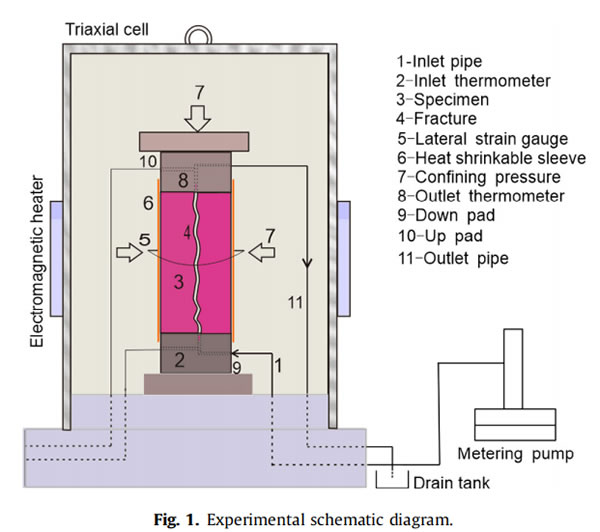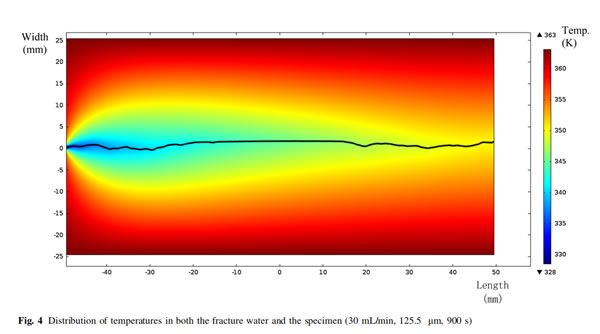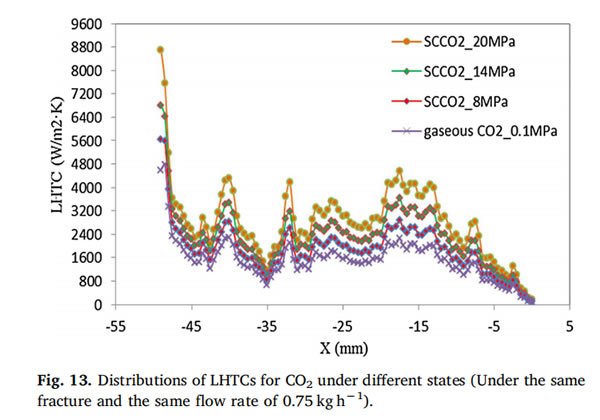Research Progress of Crack Heat Exchange in Hot Rocks in Wuhan Geotechnical Institute
The hot and dry rock geothermal resources have great potential and are green and renewable. They are a strategic energy source and are increasingly valued by major countries in the world. Deep hot rock geothermal development is usually the injection of fluid working medium (such as water, carbon dioxide) into the underground fissure channel to exchange thermal energy and circulate to the ground system. One of the important scientific issues is the flow and heat transfer characteristics of heat medium in cracks, and it is also the basis for the optimal design of mining schemes and the development of high-efficiency heat recovery technologies. To address this issue, Bai Bing, a research associate of the Institute of Rock and Soil Mechanics at the Chinese Academy of Sciences, and researcher Li Xiaochun, etc., made new progress on the basis of previous work.
The research team has independently developed a new type of coupling system for the flow and heat exchange mechanics of high-temperature fractured rock masses, and systematically studied the flow and heat transfer of water in a single fracture of a granite under different confining pressures, different confining temperatures, and different flow rates; The current formula for the overall heat transfer coefficient of cracks was verified and screened. It was found that some commonly used formulas have unreasonable conditions such as numerical oscillations or even negative values ​​under high flow conditions. A simplified formula for the overall heat transfer coefficient (OHTC) is proposed to be valid. Solved this problem. In addition, some heat transfer coefficient formulas in the derivation for the sake of easy analysis assume that the temperature of the inner wall surface is constant along the radial direction, which will lead to the problem of temperature discontinuity at (±R,0). Based on the Green's function method, the researchers proposed a new set of analytical methods for the overall heat transfer coefficient, which can effectively avoid these problems. Specific analytical solutions are given when the radial temperature is a 0-3 polynomial function distribution. A numerical model for the analysis of crack flow heat transfer was developed. The numerical modelling problem when the fracture was different from the rock by two orders of magnitude was successfully achieved. The simulation results agree well with the experimental data. The local heat transfer coefficient (LHTC) was used to characterize the local heat transfer characteristics of dry hot rock fractures. It was found that the local heat transfer coefficient is usually larger when the crack opening degree is smaller, and the local undulation degree (representing roughness) and local heat transfer coefficient of the crack are negative. The correlation is that the LHTC is larger at the crevice recess and smaller at the bulge. The LHTC is smooth at the fissures, and the roughness is larger. The fitting relationship between the LHTC and the undulation degree is given. Based on the model, the flow and heat transfer characteristics of water and carbon dioxide were simulated. It was found that under the same conditions, the overall heat transfer coefficient and local heat transfer coefficient of gaseous carbon dioxide and gaseous water increased with the increase of flow rate. The OHTC and LHTC are always smaller than the gaseous water, and the supercritical water heat transfer coefficient is better than the supercritical carbon dioxide. In the case of carbon dioxide, tight heat transfer is better than the loose phase.
The research work was funded by the National Natural Science Foundation of China (Grant 41672252, 41272263). Research results are published in Applied Thermal Engineering, Rock Mechanics and Rock Engineering, Computers and Geotechnics, Environmental Earth Sciences, and Geothermics.

Crack flow heat transfer experimental principle

Temperature distribution in granite rock masses and fissures (left injection flow 30mL/min, fracture opening 125.5 microns, time 900s)

Comparison of Local Heat Transfer Coefficients of Carbon Dioxide under Different Conditions
Liquid Detergent Ingredients,Emulsifier Laundry Detergent,Detergent Liquid Ingredients,Chemical Element In Toothpaste
XINGZHILIAN BIOLOGICALR&D CO.,LTD , https://www.xzlsdslds.com